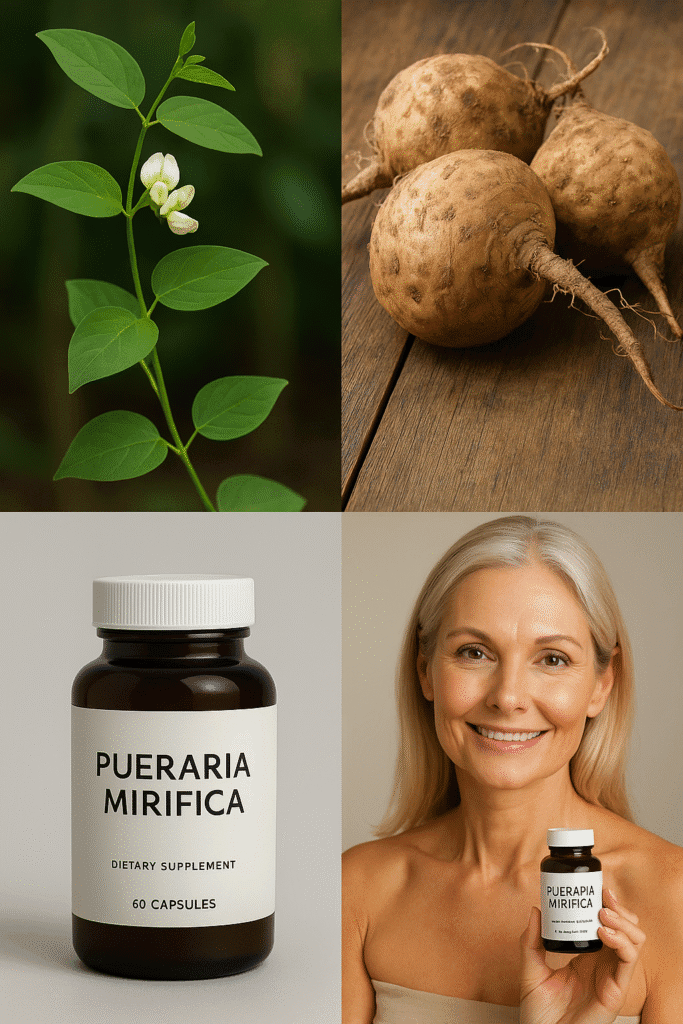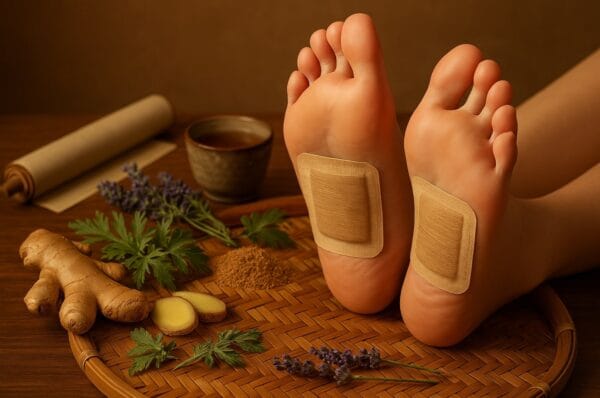Pueraria mirifica—frequently referred to as Kwao Krua—is a tuberous vine native to Thailand and neighboring regions of Southeast Asia, rich in compounds with estrogenic action.
For over a century, traditional healers have used the dried and ground root to promote vitality and youthful appearance, and modern research is now beginning to explore its effects on menopause, bone density, skin and hair health, cardiovascular function, and even brain protection [1].
Where can I find Pueraria?
Initial human trials and various animal studies suggest that standardized Pueraria mirifica extracts can alleviate hot flashes and vaginal dryness, preserve bone mineral density, improve lipid profile, and enhance antioxidant mechanisms [1][4][6], but many of these studies are small-scale, lack rigorous controls, or are based on animal models [3], making it essential that larger clinical trials are conducted and that a healthcare professional is consulted before starting any supplementation.
What is Pueraria mirifica?
Pueraria mirifica is a perennial vine whose swollen underground roots resemble potatoes; in traditional Thai medicine, these tubers are harvested, dried, and processed into powder or extracts under the name Kwao Krua [1]. The plant stands out for its high concentration of phytoestrogens—compounds like miroestrol and deoxymiroestrol, which bind to estrogen receptors in the human body [5][6].
Historical uses and cultural context
Ethnobotanical records indicate that rural communities in Thailand and Myanmar have used Pueraria mirifica for over 100 years to alleviate symptoms associated with hormonal aging, including menopausal discomfort, low libido, and skin sagging [1]. Traditional preparations range from decoctions and topical pastes to modern encapsulated supplements, marketed for “rejuvenation” and “women’s health” [3].
Main active compounds
Several phytoestrogens have been identified in Pueraria mirifica, notably miroestrol and deoxymiroestrol, whose structure mimics estradiol, the main human estrogen. These compounds activate estrogen receptors (ERα and ERβ) in various tissues, potentially modulating hormonal pathways [6].
Potential health benefits
1. Relief of menopausal symptoms
Phytoestrogens can partially replace declining estrogen levels, which is why Pueraria mirifica has been tested to combat hot flashes, night sweats, mood swings, and vaginal dryness in menopausal women [1][3]. Small-scale clinical studies report up to a 50% reduction in hot flash frequency and significant improvements in vaginal comfort after two to three months of supplementation [2].
2. Support for vaginal tissue
Topical Kwao Krua gels (1% extract) applied daily have shown promise in restoring vaginal pH and epithelial thickening, both in non-human primates and postmenopausal women, although standardized estrogen creams still show superior results [2].
3. Preservation of bone health
Estrogen deficiency accelerates bone resorption, increasing the risk of osteoporosis in postmenopausal women [4][10]. In ovariectomized rats, Pueraria mirifica supplementation preserved bone mineral density and improved bone microarchitecture [4]. Similar benefits were observed in a 16-month trial in postmenopausal monkeys [9].
4. Antioxidant effects, on skin and hair
Laboratory studies indicate that Pueraria mirifica can increase skin elasticity, even out pigmentation, and strengthen hair and nails—effects attributed to its phytoestrogenic and antioxidant activity [6][9]. In animal models, extracts elevated antioxidant enzymes in liver and uterine tissues more effectively than synthetic estrogen [9].
5. Potential anticancer effects
In vitro trials show that Pueraria mirifica phytoestrogens inhibit the proliferation of breast cancer cells, and animal studies suggest tumor suppression by miroestrol [5]. However, robust human trials are lacking, and there are data warning of estrogen-dependent proliferative risks [5].
6. Cardiovascular support
Estrogen contributes to favorable cholesterol levels; its reduction in postmenopause is associated with increased LDL and decreased HDL [1][7]. In a study with 19 postmenopausal women, supplementation raised HDL by 34% and reduced LDL by 17% in eight weeks [7].
7. Brain and neuroprotective effects
Pre-clinical research in rats suggests that Pueraria mirifica extract attenuates neuronal oxidative damage and cognitive decline, indicating potential anti-dementia effects [9]. Human studies to corroborate these results are lacking.
Dosage and safety
Most human studies use doses of 25–100 mg/day of standardized extract; protocols up to 3,000 mg/day have not reported serious toxicity [8]. Adverse events include breast pain, menstrual irregularities, and slight liver changes [3]. The lack of pharmaceutical regulation means that the concentration of phytoestrogens varies significantly between products.
How to choose a quality supplement
- Third-party testing: Brands with independent certification ensure purity and actual levels of phytoestrogens [3].
- Transparent labeling: Clear information on the miroestrol/deoxymiroestrol content per dose [3].
- Professional consultation: Essential for those with hormone-sensitive conditions or who are undergoing other medical treatments.
Conclusion
Pueraria mirifica contains potent phytoestrogens that mimic estrogenic functions, offering promise in relieving menopause symptoms, protecting bones, rejuvenating skin, and supporting cardiovascular health. However, most evidence comes from small trials, animal or in vitro studies, and standardized dosing still lacks definition. Professional advice and careful selection of supplements are recommended, pending more robust clinical trials.
You can buy Pueraria here in my store.
References
- [Healthline. “7 Emerging Benefits of Pueraria mirifica” (2025). Available at: https://www.healthline.com/nutrition/pueraria-mirifica (Accessed April 2025).
- Manonai J, Chittacharoen A, Udomsubpayakul U, Theppisai H, Theppisai U. “Effect of Pueraria mirifica on vaginal health”. Menopause. 2007 Sep-Oct;14(5):919-24. doi:10.1097/gme.0b013e3180399486. Available at: https://journals.lww.com/menopausejournal/Abstract/2007/09000/Effect_of_Pueraria_mirifica_on_vaginal_health.11.aspx (Accessed April 2025).
- Kongkaew C, Scholfield NC, Dhippayom T, et al. “Efficacy and safety of Pueraria candollei var. mirifica in menopausal women: systematic review”. Journal of Ethnopharmacology. 2018;216:162-174. doi:10.1016/j.jep.2018.01.028. Available at: https://www.sciencedirect.com/science/article/pii/S0378874118300297 (Accessed April 2025).
- Manonai J, Chittacharoen A, Udomsubpayakul U, Theppisai H, Theppisai U. “Effects and safety of Pueraria mirifica on lipid profiles and biochemical markers of bone turnover rates in healthy postmenopausal women”. Menopause. 2008 May-Jun;15(3):530-5. doi:10.1097/gme.0b013e31815c5fd8. PMID:18202589. Available at: https://pubmed.ncbi.nlm.nih.gov/18202589/ (Accessed April 2025).
- Malaivijitnond S. “Medical applications of phytoestrogens from the Thai herb Pueraria mirifica”. Frontiers of Medicine. 2012 Mar;6(1):8-21. doi:10.1007/s11684-012-0184-8. Available at: https://link.springer.com/article/10.1007/s11684-012-0184-8 (Accessed April 2025).
- Chansriwong P, Chaiwiwatana A, Raksat M, et al. “Pueraria mirifica extract and puerarin enhance proliferation and differentiation of osteoblasts”. Journal of Ethnopharmacology. 2014;151(2):972-980. doi:10.1016/j.jep.2013.11.021. Available at: https://www.ncbi.nlm.nih.gov/pmc/articles/PMC4679364/ (Accessed April 2025).
- “Pueraria mirifica: An Herb for Menopause Support?” Verywell Health. 2014. Available at: https://www.verywellhealth.com/the-benefits-of-pueraria-mirifica-88654 (Accessed April 2025).
- “Comparative pharmacokinetics of puerarin alone and in Pueraria mirifica extract”. PubMed PMID:33063303. Available at: https://pubmed.ncbi.nlm.nih.gov/33063303/ (Accessed April 2025).
- “Effects of Pueraria candollei var. mirifica extract on oxidative brain damage”. PMC8201258. Available at: https://www.ncbi.nlm.nih.gov/pmc/articles/PMC8201258/ (Accessed April 2025).
- “The role of lipoproteins in bone turnover”. PMC11411916. Available at: https://www.ncbi.nlm.nih.gov/pmc/articles/PMC11411916/ (Accessed April 2025).



